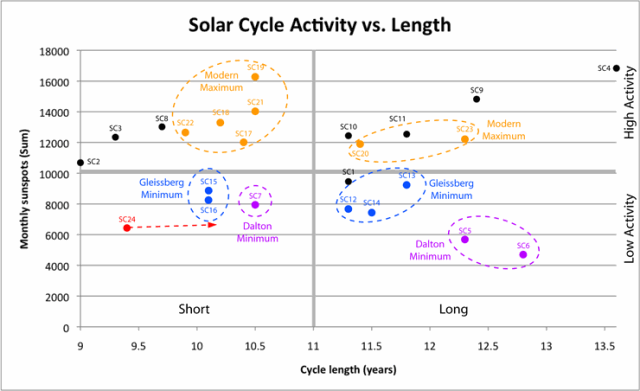
The surprising 2008 solar minimum
Solar scientists did not pay much attention to the early warning signs that the Sun was behaving differently during solar cycle 23 (SC23), and to most the surprise came when the expected solar minimum failed to show up in 2006. The SC23-24 minimum took place two years later (Dec 2008, according to SIDC), and despite showing only a tiny difference in total solar irradiation compared to previous minima of the space age, it displayed significantly reduced solar wind speed and density, extreme-UV flux was 10% reduced, the polar fields were 50% smaller, and the interplanetary magnetic field strength was 30% below past minima. In response to the changes in the Sun, the density of the Earth thermosphere dropped 20% lower than in previous minima. In 2007 Svalgaard & Cliverproposed a floor to the interplanetary magnetic field at 1 AU in the ecliptic plane of 4.6 nT based upon 130 years of data. This floor has implications for the solar wind during grand minima. After the solar minimum, in 2011, Cliver & Ling were forced to revise down the floor to 2.8 nT, a 40 percent reduction! The SC23-24 minimum was truly shocking to solar scientists, showing them how little they knew of what happens to the Sun when it becomes very inactive. And it was just a centennial-type solar minimum, not a grand-type solar minimum.
We are now approaching the SC24-25 solar minimum, and again the Sun's behavior surprises us. Or doesn't it? On April 26, NOAA informed us that "current solar cycle 24 is declining more quickly than forecast."
The rapid decline in solar activity plus the appearance of the first SC25 spots suggest that SC24 could be both a low-activity and short solar cycle. This would not be unusual since cycle length and cycle activity do not correlate significantly (figure 1).

Defining a solar minimum
While intuitively we all understand that a solar minimum is the period of time that shows the least amount of solar activity between two cycles, how the solar minimum is defined can make a difference of months in the date of the minimum. Harvey & White reviewed in 1999 the different methods used to define a solar minimum:
"In addition to the time of a minimum in the smoothed sunspot number, historically the basis for the determination of the time of cycle minimum since 1889 includes the time of the minimum or minima in the monthly averaged sunspot number, the number of spotless days, the start and end times of the minimum phase, the number of regions belonging to the outgoing (old) and incoming (new) cycles, and the use of different smoothing windows."Some of them are shown in table 1 from Harvey & White 1999.
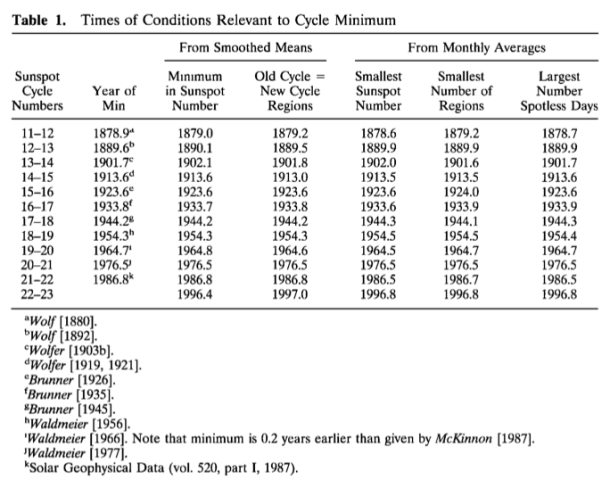
Rs= (0.5 Rm±6 + Rm±5 + Rm±4 + Rm±3 + Rm±2 + Rm±1 + Rm) / 12 .......[1]
Where Rs is the smoothed sunspot number and Rm the monthly sunspot number for the central month. The end months in the average are given half weight.
This formula produces Aug. 1996 for the SC22-23 minimum so, despite being very simple, the result is generally quite close to more complex calculations.
This formula requires that at least 7 months have passed since the minimum and produces a 6-month delay in the calculation of monthly solar activity. For this article, I wanted to reduce this delay without compromising accuracy too much, so I have used the following 9-month smoothing formula with a more skewed weighting:
Rs= (Rm±4 + 3 Rm±3 + 5 Rm±2 + 7 Rm±1 + 10 Rm) / 42 .......[2]
Figure 2 shows the result of smoothing [2] compared to SIDC smoothing [1].
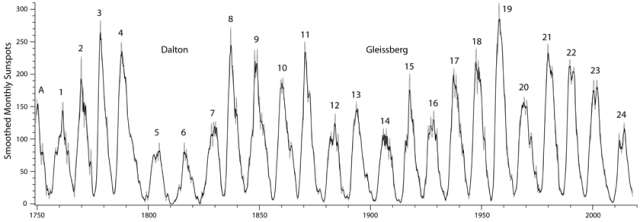
The answer is almost certainly not. We can base this answer on two kinds of data. The first is the number of spotless days. Astronomers have been counting the number of spotless days since 1818, and this number in the current minimum, as of first of June is 198 (Figure 3). As the solar minimum usually takes place after at least half of the spotless days in a minimum have taken place (the rising phase of the cycle is usually faster than the declining phase), that would imply that this minimum should have less than 400 spotless days if it ended now. Such a low number has only taken place in minima between very active solar cycles during the Modern Maximum in solar activity (1935-2005). Given that SC24 has been a low-activity cycle we should expect 200-300 spotless days more before the minimum is reached, and that is about a year of very low solar activity.
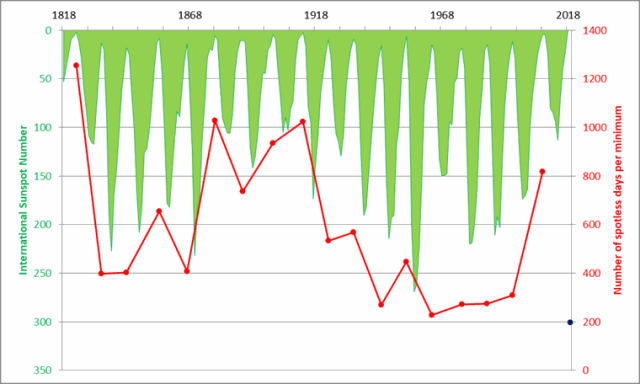

Most of the analyses I have seen have one problem. They only look at a subset of solar cycles, and the space-age records are biased by the high activity of the Modern Maximum. I have been inspired particularly by Belgian astronomer Jan Janssens' SC24 tracking webpage. Using the smoothing filter [2], and following Janssens, I have defined the starting point of the analysis of each minimum as the last month that showed ≥ 30 monthly smoothed sunspots before the minimum. In figure 5 I have represented the number of months it took for each transition from that starting point to reach its solar minimum (lowest smoothed monthly sunspot number or central month when several consecutive zero values).
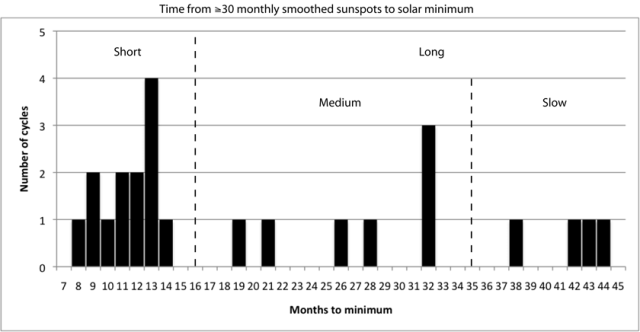
The present solar minimum does not belong to the group characterized by short solar minima. The sunspot number is falling too abruptly, and the solar minimum should have been hit by December 2017 to belong to the group. As of June (corresponding to January 2018 smoothed data) the smoothed sunspot number is still decreasing and given the evolution it will decrease again next month.
The present solar minimum could belong to the medium group. This group includes solar cycle minima from the Dalton and Gleissberg extended minima, but also the unusual 1986 SC21-22 minimum. If SC24-25 belongs to this group the minimum should take place between May 2018 and September 2019. For that to happen the decrease in sunspots should slow down soon, since the chance that its smoothed value hits zero or near-zero is quite low, as only one of the seven (SC6-7) in this group did so.
The present solar minimum could also belong to the slow group. As we can see fast declines in sunspots are common in the early phase of this group, but they are usually followed by a recovery of activity that can last up to a year before the decline resumes. The last SC23-24 minimum belonged to this group and they usually reach very low values or even zero as in the case of the extreme 1810 SC5-6 Dalton solar minimum. If SC24-25 belongs to this group, the minimum should take place between late 2019 and mid-2020. For that to happen the decrease in sunspots should actually revert soon and increase for several months before declining again.
Considering all solar minima since 1750, we can say that it is most likely that the SC24-25 minimum will take place between the summer of 2018 and the summer of 2020.
Reasons why it is likely that SC24-25 turns out to be a long solar minimum
The reason why a slower decay of sunspots had been predicted for SC24 is that the rising and decaying phases of past solar cycles were generally slower for low-activity cycles than for high-activity cycles, so the minima of low-activity cycles tend to last longer than average. We can see this in figure 9.
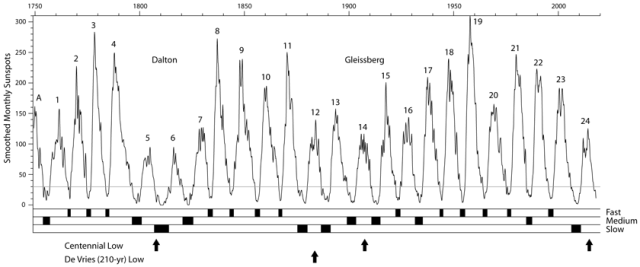
Additionally, we observe that most of the long minima, and particularly the longest ones, take place at the lows of the centennial and de Vries (210-yr) cycles of solar activity (arrows in figure 9). As we are currently at a centennial low in solar activity it is more likely than not that the SC24-25 minimum is a long one. Thus, SC24 should not be a particularly short cycle.
We can also get an idea of when the SC24-25 minimum might take place by looking at the speed that some solar features are "migrating" towards the equator. Sunspots are not useful for this, but looking at regions of local maxima in the spectral corona at the Fe XIV 530.3 nm line we can still see them appearing closer to the equator (figure 10; Aliev et al., 2017).
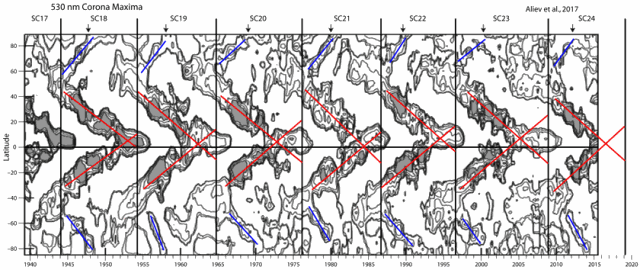
A similar analysis has been done more in depth by Petrovay et al., 2018 using another feature of the green coronal line, the rush-to-the-poles (RTTP) coronal polar regions. These are active coronal regions that appear at ~ 55-60° at the time of the solar minimum but move progressively closer to the poles, reaching them near the time of the solar maximum (blue lines in figure 10). This "migration" is postulated to be a manifestation of the buildup of the poloidal field.
Petrovay et al., 2018 find a correlation between the rise rate of the RTTP and the time delay from the ending of the RTTP to the maximum of the following cycle. A rapid rise of the RTTP rate indicates the maximum of the next cycle will take place earlier. From that correlation they expect the maximum of SC25 to occur at October 2024.
From that prediction they use two other known correlations, the Waldmeier effect, or anti-correlation between time from cycle minimum to maximum and cycle amplitude (figure 11A), and the correlation found between the amplitude 2.5 years before the minimum and the amplitude at maximum (figure 11B). Using these two correlations Petrovay et al., 2018 deduce that SC24-25 minimum will take place at April 2019 and SC25 will have an amplitude of 130 smoothed sunspots, same as SC16 and slightly above SC24 (116 sunspots). The date they give is in general agreement with the rest of the information presented here.

The Australian Bureau of Meteorology Space Weather Services runs a solar activity pageon monthly sunspot numbers and 10.7 cm solar radio flux. They predict a solar minimum slightly lower than the SC23-24 minimum for July 2019. No information is provided about the model they use.
SILSO also runs several prediction methods. The Standard Curves method (SC, based on Waldmeier) and the Combined Method (CM, based on Denkmayr & Cugnon) are part of the 13-year sunspot number and forecast graph displayed at SILSO home page (figure 12A). Over the past year the CM method performed quite badly, predicting more than double the activity that has been observed (figure 12A, black curves), while the SC method has performed better. For the next year the SC method predicts a fall to zero sunspots average for at least 11 months starting this month (figure 12B). I consider that prediction to be very unlikely. The CM method predicts a solar minimum for February 2019 (figure 12C), which is in general agreement to the evidence presented. A third method not shown, the McNish & Lincoln method, is also available at the forecasts page of SILSO, and predicts the solar minimum for December 2018.

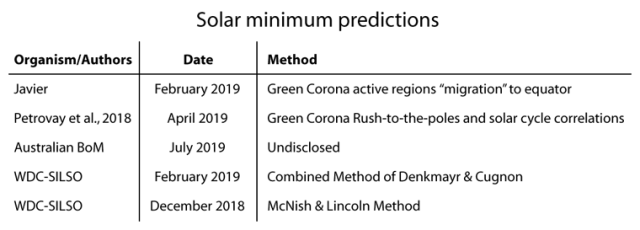
At this time everything appears to indicate that the SC24-25 minimum should take place by late 2018 to mid-2019. If this is the case SC24 will be ~ 10-10.5 years long, not unusual for a solar cycle. The time from ≥ 30 sunspots to the minimum should be above 24 months, but probably below the 38 months of the SC23-24 minimum. Since the length of the low activity period is usually related to its depth, it is likely that the SC24-25 minimum should not be as deep as the SC23-24 minimum. This is in contrast with the recent prediction by James Marusek at WUWT that "this upcoming period of minimal sunspots shall be longer and deeper than the last one."
As usual, extreme opinions that this could be a monster minimum (David Archibald, 2017), or that it will take place so soon (or already) that will make SC24 one of the shortest cycles, are unlikely to be correct.
If the minimum takes place indeed by early 2019, we can expect the next minimum by 2029-30, indicating that the current period of below average solar activity should extend until ~ 2032. Afterwards I expect that solar activity should return to levels typical of the 20th century Modern Maximum.
Bibliography
Aliev, A. K., Guseva, S. A., & Tlatov, A. G. (2017). Results of Spectral Corona Observations in Solar Activity Cycles 17-24. Geomagnetism and Aeronomy, 57(7), 798-802.
Cliver, E. W., & Ling, A. G. (2011). The floor in the solar wind magnetic field revisited. Solar Physics, 274(1-2), 285-301.
Harvey, K. L., & White, O. R. (1999). What is solar cycle minimum?. Journal of Geophysical Research: Space Physics, 104(A9), 19759-19764.
Petrovay, K., Nagy, M., Gerják, T., & Juhász, L. (2018). Precursors of an upcoming solar cycle at high latitudes from coronal green line data. Journal of Atmospheric and Solar-Terrestrial Physics.
Svalgaard, L., & Cliver, E. W. (2007). A floor in the solar wind magnetic field. The Astrophysical Journal Letters, 661(2), L203.
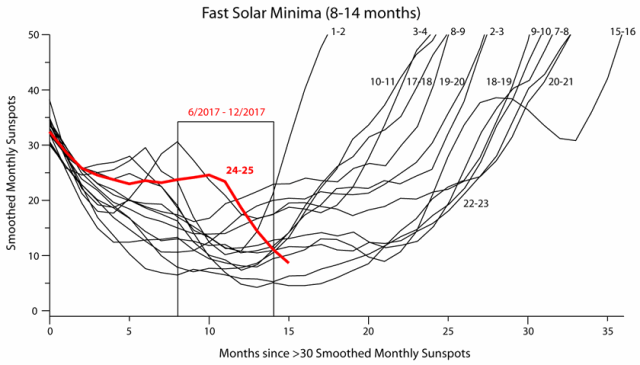
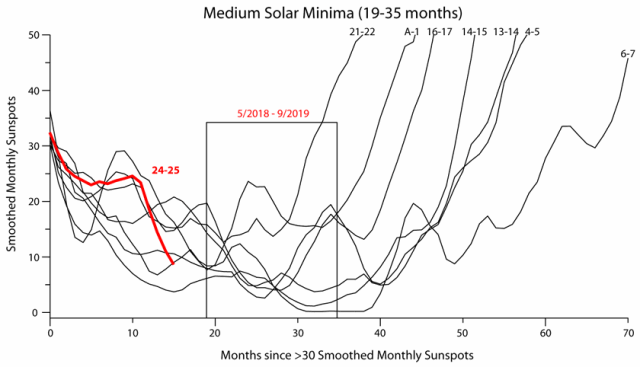
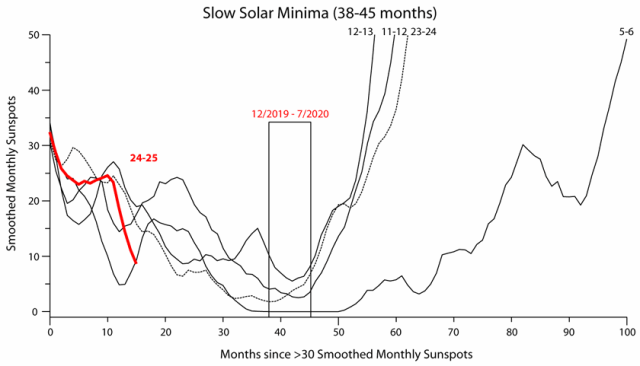


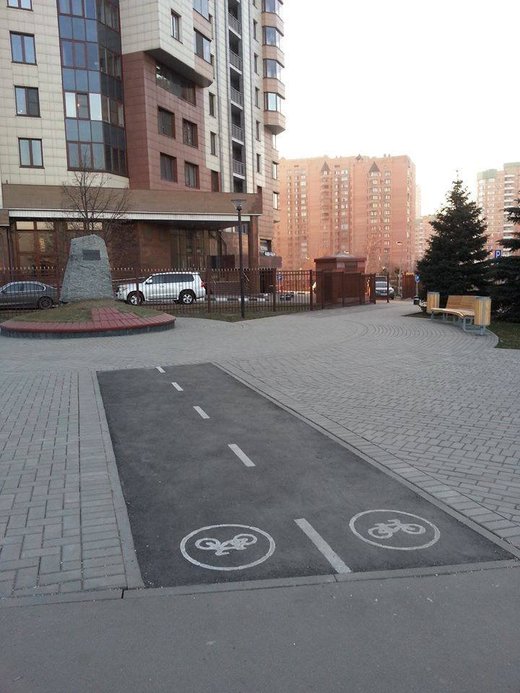
Comment: Further reading: Study predicts next phase of solar cycle will bring on 'Mini Ice Age' as early as 2020